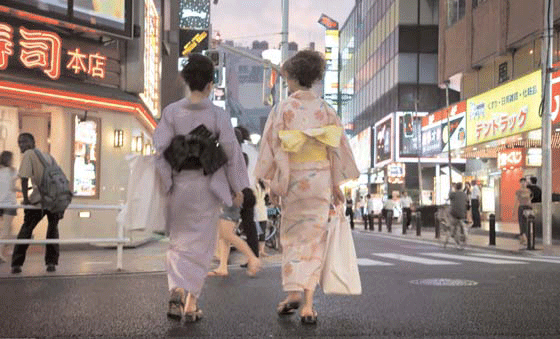The Independent's journalism is supported by our readers. When you purchase through links on our site, we may earn commission.
Japan: Where the past and future mix

Elegant kimonos, geishas with their stylised hair and make-up, ancient temples with gates and pagodas: this is often the impression that Western visitors have of Japan.
But the 21st-century reality is very different. These days, high-speed – and high-tech – bullet trains link Japan’s main cities; visitors to Tokyo can cruise the Sumida river in the Himiko, a floating craft that is more like a spaceship than a boat; and modern technology has been applied to every area of Japanese life.
Robots are everywhere – a robot recently conducted a Japanese wedding ceremony – although the best place to find out what they can really do is the National Museum of Emerging Science and Innovation.This fascinating display presents a vision of the future across many branches of science, but, even if your interest in scientific matters is limited, it is hard not to be impressed by the museum’s Robot World, where the technology is so advanced it is often hard to distinguish between robots and humans.
Modern art, as well as science, is a feature of Tokyo, too, and it has its focus in the district of Roppongi Hills. Here, the National Art Centre, the Suntory Museum of Art and the Mori Art Museum make up Art Triangle Roppongi. The result is an extensive showcase for contemporary art, displayed in a variety of temporary exhibitions, all within easy reach of each other. The Mori museum is particularly notable for its location, at the top of a tower known as the Museum Cone, a funnel shaped building clad in concrete and covered with glass and translucent ceramics so it glows at night.
For more than 50 years, the Tokyo Tower has dominated the city’s skyline, but it is set to be eclipsed when construction of the futuristic Tokyo Sky Tree is finished next year. Designed by the well-known Japanese architect, Tadao Ando, it will take over the functions of the older tower, but the area around will be put to better use with new shopping areas and office facilities. Ando’s work is also prominent in Kyoto, notably at the Garden of Fine Arts, where famous works of art are reproduced on ceramic plates in an open-air museum constructed below ground level.
And south-east of Kyoto, near the town of Shigaraki, is the Miho Museum, designed by IM Pei to house a private art collection. Much of the building is carved out of the mountainside, and the dramatic mix of glass, steel, and French limestone threatens to upstage the works inside it. Kyoto itself is steeped in history, but is also the home of such contemporary products as Nintendo. The company originally manufactured playing cards, but is now better known for Pokémon, the Game Boy and the Wii. Gadgets such as these, and many more products that have yet to make their way into Europe, can be found in the Akihabara electronics district in Tokyo. And for car-lovers eager to find out what they might be driving in years to come, an afternoon spent at the Toyota complex will be a revelation. Although it contains a garage full of past designs, future models are showcased here, too.
One of Japan’s most creative industries is fashion: the range on offer stretches from Onitsuka Tiger trainers, whose cool factor has increased each time they’ve appeared in a Hollywood movie, to clothes designed by Issey Miyake and Yohji Yamamoto, not forgetting high-street names such as Muji and Uniqlo.
Japan Fashion Week, which takes place from 15-24 October, has established itself in the international fashion calendar, and anyone wanting to get ahead of the trend can find clothes by up-and-coming designers in the upmarket stores on Omotesando, or in the livelier boutiques on Takeshita Street in the Harajuku district.
Ancient but modern
The city of Kyoto is renowned for its history as an ancient imperial capital, full of elegant shrines and attractive gardens. But anyone visiting now will find a city full of contemporary attractions, from cafes to crafts.
Cocon Karasuma takes traditional woodblock-printed paper from its origins in the 16th century, and brings it into modern times. For 12 generations, the Senda family has been making “karakami” paper, now adapted to blend into any contemporary interior setting. At Kyoto Homay, denim is combined with traditional kimono fabrics and adorned with typical Japanese motifs such as cherry blossom to create everyday clothing that has a striking oriental twist.
Sou-Sou specialises in tabi - ankle socks where the big toe is separated from the others - and traditional cotton smocks, known as samue. It combines the designs with contemporary Finnish Marimekko prints, turning them into trendy cycling gear.
Flights
Virgin Atlantic flights to Tokyo from £619 per person*, for more information or to book visit virginatlantic.com or call 0844 209 4700.
Visit the Japan National Tourism Organization website, www.seejapan.co.uk.
*The Virgin Atlantic Fare shown is for a selected travel period only and must be purchased 7 days prior to departure. Subject to date of booking and departing between 01 Nov 10 – 31 Jan 11 (excluding 10 – 31 Dec 10). Book by 07 Oct 2010.Fares include all pre-paid taxes, fees and surcharges. Credit card charges apply. Subject to availability. Minimum of one Saturday night stay required. Full terms and conditions apply - for these please visit www.virginatlantic.com.
Subscribe to Independent Premium to bookmark this article
Want to bookmark your favourite articles and stories to read or reference later? Start your Independent Premium subscription today.

Join our commenting forum
Join thought-provoking conversations, follow other Independent readers and see their replies